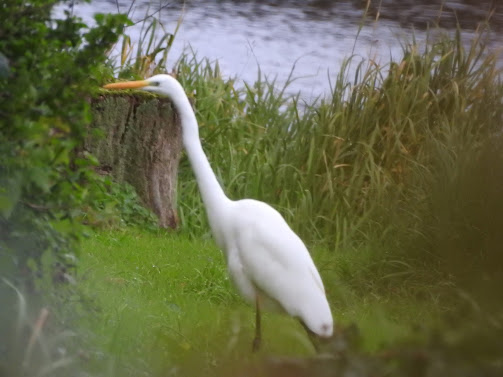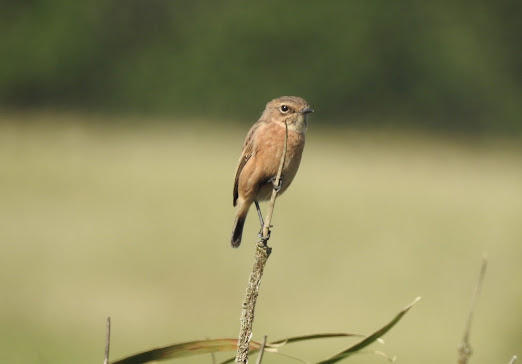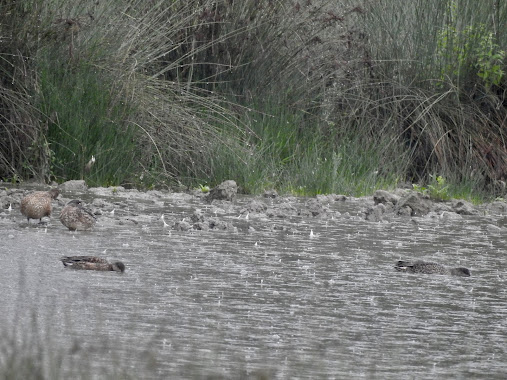For the second time I have spurned Morton Bagot in favour of taking part in the West Midlands all-dayer at Earlswood. My excuse is that I'm no longer a Twitter subscriber, and to be honest I enjoyed the Earlswood vibe so much in the spring all-dayer that I didn't want to miss out.
They're very well organised at Earlswood. John Sirrett co-ordinates all the counts and the Earlswood Whatsapp Group facilitates all the "players" the opportunity to report their sightings promptly.
I arrived early, and spent an hour from 06.30 am on the causeway in misty murky conditions seeing absolutely nothing out of the ordinary. By the time I had to leave to help Lyn get her act together, the best bird located was the Mandarin at Terry's Pool. My only contribution to the list was a Kingfisher.
On my return I chose to lurk around the Springbrook Lane and Scrublands area, but once again only saw species which were already on the list. I also missed John Sirrett's fly-over Tree Pipit which would have been a year tick.
My luck changed late in the morning when I decided to head towards the Craft Centre where most of the hirundines seemed to be gathering. I duly caught up with a Sand Martin and numerous House Martins, and Swallows. A flock of 100+ Starlings were also already on the list, but were impressive to see nonetheless. The hirundines started kicking off and I looked up to get an excellent view of a Hobby powering through them.
I moved along the road to Field Cottage, an area where Matt had found a Redstart on the spring all-dayer. There was nothing that good today, but I did add Linnet (a flock of 21), Kestrel, and Lesser Whitethroat to the list. At last I was contributing.
 |
| Kestrel |
Back on Engine Pool I spotted a youngish Yellow-legged Gull and this time it seems it really was one, having been identified initially in late August. My understanding was that it was a third-calendar year bird, although the bill and eye colour implied something younger.
By now it was much later than I had told Lyn I would be back, so I headed home. I thought that would be it for the day, but I hadn't reckoned on the day's star find being located by Peter Morgan. Two Sandwich Terns had dropped in at 15.30, so I made excuses and headed back to the lakes.
I arrived in the Malthouse car-park in time to discover that the birds had flown to Windmill Pool and were "showing well" at Windmill Pool. I broke into a run and found myself acting as a pacemaker for a jogger pounding along behind me. I arrived on the causeway completely out of breath, but in time to see the terns fly back down Engine Pool to the area I had just vacated. To cut a long story short I retraced my steps and had reasonable views of them on one of the rafts.
They were an adult and its chick, the adult giving the classic "kyrriak" call, and the youngster responding with a plaintive "tseeee" call. They were determined to stick together whenever they flew around, the calls getting more anxious when the distance between them became too great. The only downside was that the drizzle became increasingly intense while I was there, so that by the time John had returned (minus his bins) seeing them was a very soggy experience.Another species which could be added to the list was Mute Swan, three having arrived at about the same time as the terns did. They were my final tick of the day.
To the best of my knowledge the team's final bird was a Tawny Owl found by Matt late in the evening and was species number 65.
I have no idea how this compares to other sites, but I imagine the fact that not a single wader was seen by anyone and no-one could locate a Green Woodpecker all day means that Earlswood was quite low down in the rankings.
It matters not, and was a lot of fun for everyone who took part.
PS: the late addition of a sound recorded Common Sandpiper heard by John Sirrett's phone, but not by John or myself, while we were standing in the rain watching the Sandwich Terns takes the final total to 67. Apparently Earlswood was joint 15th. I'm not sure how many teams took part, hopefully more than 16!





























